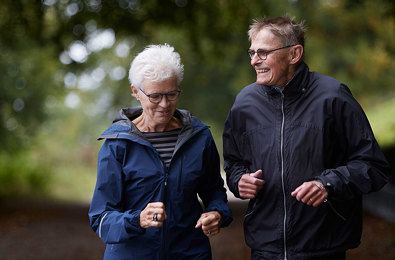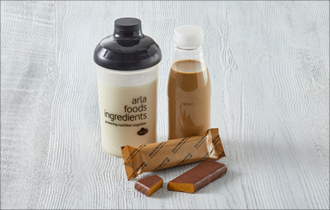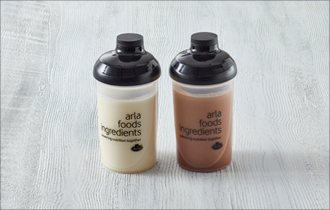Bones stay strong with milk minerals and protein
Declining bone mass is a fact of ageing1. But with the right combination of good quality nutrients in the diet, it’s possible to support bone mass and reduce the risk of osteoporosis2 – a prevalent bone disease associated with a high risk of fractures and lost mobility and independence in later life3.
Sufficient daily intake of protein, calcium, phosphorus and magnesium is essential to bone health2, 4. Within the EU, the European Food Safety Authority (EFSA) has authorised bone-related health claims related to the maintenance of normal bones for all these nutrients5.
The importance of nutrient interplay
At Arla Foods Ingredients, our natural milk mineral concentrate is rich in calcium, phosphorus and magnesium. The calcium to phosphorus ratio closely resembles that of bones and human milk6 and supports the nutrient interplay that helps to keep bones strong. For example, phosphorus improves calcium bioavailability by reducing calcium excretion via the kidneys7. Calcium bioavailability – the amount of calcium available for physiological function8 - is key to maintaining bone mass.
Improving calcium absorption
A contributing factor in age-related bone loss is the reduced capacity for calcium absorption9. By combining milk minerals such as calcium with casein phosphopeptides (CPP), absorption can be improved10. The ability of CPP to bind calcium in the small intestine helps create the right conditions for calcium to be absorbed efficiently11.
Reducing the fracture risk
Studies of older adults have revealed higher bone mineral density12, 13 and a reduced fracture risk14, 15 among those with a high protein intake. Intake of animal-derived protein was also associated with the highest bone mineral density12.
These findings have contributed to the expert recommendation that daily protein intake should be at least 1.0-1.2 grams per kilo body weight to reduce the risk of osteoporosis2. Dairy products are included in the recommendation as a source of high-quality protein. However, the benefits for bone health can only be obtained if protein is combined with sufficient calcium intake2, 16.
As a balanced source of protein, calcium and phosphorus, micellar casein isolate delivers multiple nutrients to seniors who need more protein and minerals in their diet. An Australian study of elderly people in nursing homes has shown that extra intake of dairy-based protein and calcium both reduced loss of bone mineral density and the number of falls and fractures17.
REFERENCES
- Weaver, C.M., et al., The National Osteoporosis Foundation’s position statement on peak bone mass development and lifestyle factors: a systematic review and implementation recommendations. Osteoporosis International, 2016. 27(4): p. 1281-1386.
- Biver, E., et al., Dietary recommendations in the prevention and treatment of osteoporosis. Joint Bone Spine, 2022. 90(3): p. 105521.
- Salari, N., et al., The global prevalence of osteoporosis in the world: a comprehensive systematic review and meta-analysis. Journal of Orthopaedic Surgery and Research, 2021. 16(1).
- Rizzoli, R., Dairy products and bone health. Aging Clinical and Experimental Research, 2022. 34(1): p. 9-24.
- Commission Regulation (EU) 432/2012 of 16/05/2012. Official Journal of the European Union.
- Bonjour, J.P., Calcium and phosphate: a duet of ions playing for bone health. J Am Coll Nutr, 2011. 30(5 Suppl 1): p. 438s-48s.
- Fenton, T.R., et al., Phosphate decreases urine calcium and increases calcium balance: A meta-analysis of the osteoporosis acid-ash diet hypothesis. Nutrition Journal, 2009. 8(1): p. 41.
- Etcheverry, P., M.A. Grusak, and L.E. Fleige, Application of in vitro bioaccessibility and bioavailability methods for calcium, carotenoids, folate, iron, magnesium, polyphenols, zinc, and vitamins B(6), B(12), D, and E. Front Physiol, 2012. 3: p. 317.
- Heaney, R.P., et al., Calcium absorption in women: relationships to calcium intake, estrogen status, and age. J Bone Miner Res, 1989. 4(4): p. 469-75.
- Hansen, M., et al., Casein Phosphopeptides Improve Zinc and Calcium Absoption from Rice-Based but not from Whole-Grain Infant Cereal. Journal of Pediatric Gastroenterology and Nutrition, 1997(24): p. 56-62.
- Tenenbaum, M., et al., Identification, production and bioactivity of casein phosphopeptides – A review. Food Research International, 2022. 157.
- Groenendijk, I., et al., Protein intake and bone mineral density: Cross‐sectional relationship and longitudinal effects in older adults. Journal of Cachexia, Sarcopenia and Muscle, 2022.
- Weaver, A.A., et al., Effect of Dietary Protein Intake on Bone Mineral Density and Fracture Incidence in Older Adults in the Health, Aging, and Body Composition Study. J Gerontol A Biol Sci Med Sci, 2021. 76(12): p. 2213-2222.
- Groenendijk, I., et al., High Versus low Dietary Protein Intake and Bone Health in Older Adults: a Systematic Review and Meta-Analysis. Comput Struct Biotechnol J, 2019. 17: p. 1101-1112.
- Wallace, T.C. and C.L. Frankenfeld, Dietary Protein Intake above the Current RDA and Bone Health: A Systematic Review and Meta-Analysis. Journal of the American College of Nutrition, 2017. 36(6): p. 481-496.
- Rizzoli, R., et al., Benefits and safety of dietary protein for bone health—an expert consensus paper endorsed by the European Society for Clinical and Economical Aspects of Osteopororosis, Osteoarthritis, and Musculoskeletal Diseases and by the International Osteoporosis Fou. Osteoporosis International, 2018. 29(9): p. 1933-1948.
- Iuliano, S., et al., Effect of dietary sources of calcium and protein on hip fractures and falls in older adults in residential care: cluster randomised controlled trial. BMJ, 2021. 375: p. n2364.





